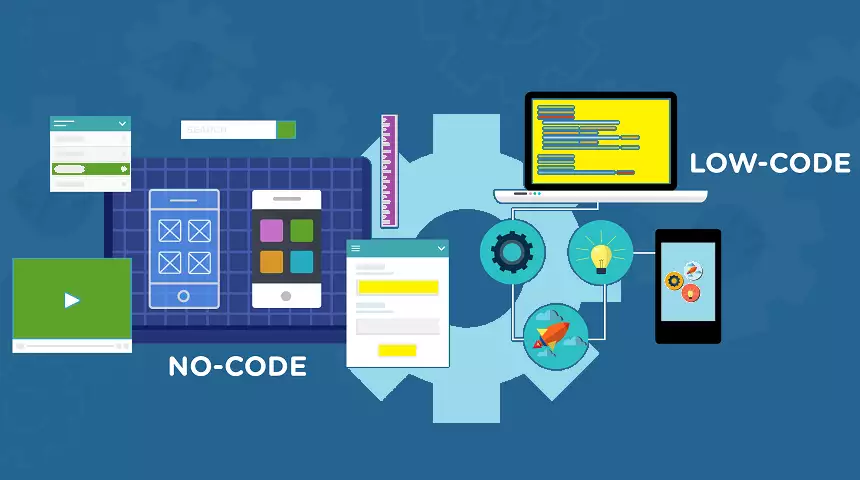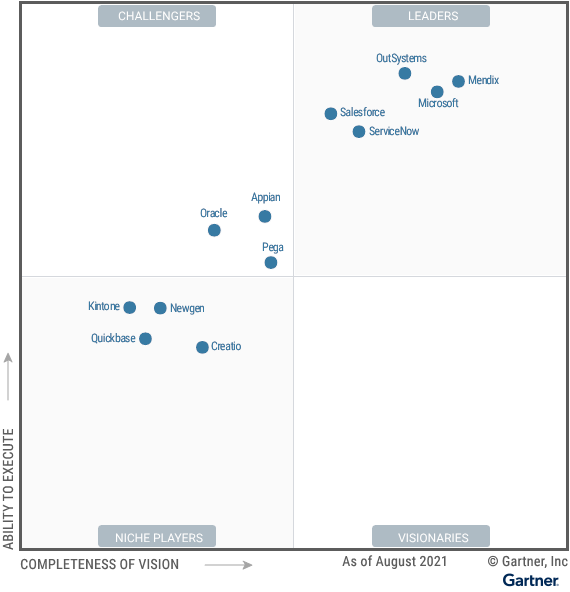LCNCP seek to simplify the creation of software by requiring little or no programming knowledge. They allow the creation and deployment of computer applications, visually by dragging and dropping pre-made components. The promise of these LCNCPs is to provide business users (“citizen developers”) with a platform that they can quickly build applications without involving software development specialists or doing so minimally.
Consultants such as Gartner and KPMG forecast that in less than three years, there will be a notable increase in the adoption of these technologies from medium to large companies, driven by the need to respond quickly to market demands, as well as by the growing shortage of specialized personnel in the IT sector.
Given this panorama, it is pertinent to ask ourselves if this represents a real threat to the software development sector or, on the contrary, can be treated as an opportunity.

What Are Low-Code/No-Code Platforms (LCNCP)?
They are application development platforms that enable rapid application delivery with minimal coding, and quick setup and deployment. The term generally refers to any class of software and tools that provide:
- Interactive visual programming environment.
- Drag-and-drop capabilities.
- Visual modeling tools.
- Prebuilt templates.
- Ease of integration with third-party tools and solutions.
Although the terms No-Code and Low-Code are usually always used together, there is a slight difference that should be specified. The difference is indicated in their very names, and it is related to the level of programming that we need to apply to achieve the desired software product.
No-Code Platforms (NCP) refer to those that allow us to create applications without requiring any level of programming at all. On the other hand, Low-Code Platforms (LCP) also allow us to build applications but give us the ability to extend the solution using programming.
In this sense, the NCPs provide solutions for specific segments, sectors, and industries, where there is already an established knowledge base and the customization need is lower. On the contrary, LCPs can be considered somewhat more general purpose, depending on the degree of programming that is allowed.
LCNCP and the Historical Evolution of Software
The evolution of software has always had to do with raising the level of abstraction and in this way, we have been able to address increasingly larger and more complex problems in all fields of human activity. It would be unimaginable to try to solve the challenges we currently face without software support. Managing a higher level of abstraction is what has allowed us to better model things in the context of our interests.
Software has evolved from machine-level code, through assembly languages, general-purpose languages (structured and/or object-oriented), CASE tools, 4GL, and domain-specific languages. This evolution has been taking, up to now, the form of programming languages with their own paradigms and variants; but now we can consider the LCNCP as the next link in this software evolutionary chain. Although they are not “formal programming languages”, they are the new tools that allow us to create software applications in less time and with fewer resources. Due to their higher level of abstraction, we only need to worry about specifying the characteristics of our application and not about how to technically implement them.
These LCNCPs have been in existence for at least two decades and have been constantly evolving and can be considered to emerge as an evolution of the Model Driven Engineering movement.
LCNCP vs Traditional Development
Every business has a unique set of difficulties that necessitate customized solutions. Traditional development can develop unique applications, but at a significant expense in terms of budget, development and go-to-market time, and timely maintenance. As a result, it is not a desirable scenario for most businesses/organizations. LCNCP on the other hand, provide organizations with the appropriate tools for application development. They boost an organization’s overall efficiency, morale, and production.
Certain criteria can be used to differentiate between low-code and traditional development as depicted in the following table:
|
Reasons to Use LCNCP vs Traditional Development
|
|
|
Low-Code/No-Code Platform |
Traditional Development |
|
|
LCNCP Advantages/Disadvantages
|
Advantages |
Disadvantages |
|
Business Agility Companies can quickly come up with solutions that meet the demands of their sector in less time. |
Limited Flexibility If you need a functionality that is not available in this platform, then the software development team will have to write custom code. Integrating this custom code will sometimes be the most costly. |
|
Increased Productivity As the time spent on software development is reduced, businesses can concentrate on more pressing tasks and projects. |
Security and Risks The main issues come from the “citizen developer” who doesn’t have the specialized skills to take care of the technical aspects of security and must rely on the security provided by the vendor. |
|
Democratize Application Development Allow business users to build applications even with zero to minimal coding skills. |
Vendor Lock-In The more a business invests in the use of a specific platform, the more difficult it is for them to switch to a different platform. This increases the dependency of the business on an individual vendor. |
|
Saving Costs Compared to the traditional approach, it costs way less to businesses. |
The Complication of Business Logic Certain platforms are ideal for automating simple processes or creating prototypes. In certain situations, business logic gets complicated once the prototyping phase is completed. |
|
User Experience These come with a varied range of built-in widgets, and UI patterns, which act as building blocks that offer better UI/UX. |
|
Growth Expectations for LCNCP Market
The LCNCP market is constantly rising. It also happens because of the growing users’ interest in this technology.
According to Gartner, almost 65% of major corporations would employ at least four LCNCP for digital application development by 2024 year-end, enlarging this market more and more. [1]
KPMG reports that 100% of enterprises that have put a LCNCP into place have reported a positive ROI2. They also say that the number of business executives who list this type of development as their most important automation investment has nearly tripled since the pandemic began.
Other consultants such as Statista says that the global low-code platform market revenue is valued at almost 13 billion U.S. dollars in 2020 and is forecast to reach approximately 65 billion U.S. dollars in 2027 [3]. The market is projected to grow with a Compound Annual Growth Rate (CAGR) of 26.1 percent over this period.
Similarly, Markets and Markets says that the global LCNCP market size is projected to grow from USD 13.2 billion in 2020 to USD 45.5 billion by 2025, at a CAGR of 28.1% during the forecast period. The increasing need of digitalization and maturity of agile DevOps practices are expected to enhance the use of low-code development platform market across the globe [4].
Most Prominent LCNCP Vendors
Gartner has identified 12 of the most prominent Enterprise LCNCP vendors in the industry. The authors of the research evaluated each provider’s strengths and weaknesses and graded them on the “Magic Quadrant” chart, which tells readers how effectively each provider can carry out their goal. Leaders demonstrate both strong execution (particularly in terms of business performance) and a strong vision (in terms of product and go-to-market strategies). These vendors stand out in a highly competitive, global market and serve a wide range of organizations and application use cases with their robust Enterprise LCNCP offerings. Leaders are Mendix, OutSystems, Microsoft, Salesforce, and ServiceNow [5].

Conclusions
The LCNCP is not a passing technology, and has been evolving for almost 20 years.The functionalities have matured a lot, making real the possibility of building software even without knowing or knowing little about programming languages, thus allowing business users to build software applications that the company needs to meet the demands of its markets.
Although much of the technological knowledge to run the applications created by "citizen developers" is cleverly codified in the LCNCP; there are still areas, such as managing information security, the complexity of certain business functions, or the governance of multiple LCNCP applications which require the participation of "professional developers", to work together with "citizen developers" in a more integrated way and closer to the business domain.
In this scenario, we can see that the LCNCP does not represent a threat to the software development industry or to specialists in that sector. On the contrary, they would be a great opportunity to increase their capabilities by incorporating the LCNCP in their arsenal of tools to take advantage and make software applications available to companies in a short time, but of better quality, with greater security and better governance.
References
- Gartner forecast: https://www.bloomberg.com/press-releases/2019-08-12/low-code-is-the-future-outsystems-named-a-leader-in-the-2019-gartner-magic-quadrant-for-enterprise-low-code-application
- KPMG study: https://advisory.kpmg.us/articles/2020/low-code-unifying-fabric.html
- Statista report: https://www.statista.com/statistics/1226179/low-code-development-platform-market-revenue-global/
- Markets and Markets report: https://www.marketsandmarkets.com/Market-Reports/low-code-development-platforms-market-103455110.html
- Gartner Magic Quadrant for Enterprise LCNCP: https://www.outsystems.com/1/low-code-application-platforms-gartner-/
About Encora
Fast-growing tech companies partner with Encora to outsource product development and drive growth. Contact us to learn more about our software engineering capabilities.